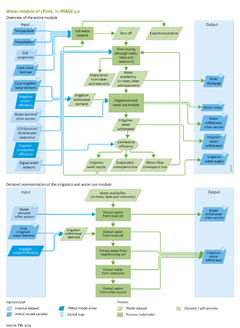Water/Description: Difference between revisions
< Water
Jump to navigation
Jump to search
m (RinekeOostenrijk moved page Hydrological cycle/Description to Water/Description without leaving a redirect: Text replace - "Hydrological cycle" to "Water") |
m (Text replace - "Livestock" to "Livestock systems") |
||
| Line 32: | Line 32: | ||
===Water demand in other sectors=== | ===Water demand in other sectors=== | ||
The IMAGE-LPJmL model only calculates agricultural water demand internally, hence water demand in other sectors (household, livestock, manufacturing and electricity) is calculated separately. For household and manufacturing sectors data and algorithms are adopted from the WaterGAP model ([[Alcamo et al., 2003]]). For the electricity sector, a process-based estimation is used, based on the study by ([[Davies et al., 2013]]), and livestock demand follows from the number of heads, estimated in the livestock production model (see [[Livestock]]), with the water demand per head adjusted for climate conditions. Domestic demand is a function of population size and per-capita income, corrected for the share of the population without access to a piped water supply (see [[Human development]]). Manufacturing demand is a function of industrial value added, corrected for changes in sector composition; for example, the structural change factor also used for energy demand (see [[Energy supply and demand]]). For the electricity sector, a technology-based approach was adopted from the study by ([[Davies et al., 2013]]). The type of power plant (e.g. standard steam cycle, combined steam cycle) determines the demand for cooling capacity. Cooling demand is also corrected for cogeneration of heat and power, as those plants require far less cooling capacity. In addition, the type of cooling facility in place determines how much water is required. Once-through cooling systems use large volumes of surface water that are returned almost entirely to the water body that they were extracted from, albeit at an elevated temperature. Wet cooling towers exploit the evaporation heat capacity of water and, hence, require much lower water volumes. However, a significant part of the cooling water evaporates during the process and does not return to the original water body. In some regions, cooling ponds are used, where cooling water is pumped and recycled in a closed loop, with water demand characteristics somewhere in-between the once-through and wet tower cooling systems. Finally, dry cooling systems are deployed that use air as a coolant and, therefore, require no cooling water at all. Based on data from ([[Davies et al., 2013]]), market shares of types of cooling systems – for each power plant type distinguished in [[TIMER model|TIMER]], in each world region – are combined with energy input requirements to arrive at the total water demand for the electricity sector. | The IMAGE-LPJmL model only calculates agricultural water demand internally, hence water demand in other sectors (household, livestock, manufacturing and electricity) is calculated separately. For household and manufacturing sectors data and algorithms are adopted from the WaterGAP model ([[Alcamo et al., 2003]]). For the electricity sector, a process-based estimation is used, based on the study by ([[Davies et al., 2013]]), and livestock demand follows from the number of heads, estimated in the livestock production model (see [[Livestock systems]]), with the water demand per head adjusted for climate conditions. Domestic demand is a function of population size and per-capita income, corrected for the share of the population without access to a piped water supply (see [[Human development]]). Manufacturing demand is a function of industrial value added, corrected for changes in sector composition; for example, the structural change factor also used for energy demand (see [[Energy supply and demand]]). For the electricity sector, a technology-based approach was adopted from the study by ([[Davies et al., 2013]]). The type of power plant (e.g. standard steam cycle, combined steam cycle) determines the demand for cooling capacity. Cooling demand is also corrected for cogeneration of heat and power, as those plants require far less cooling capacity. In addition, the type of cooling facility in place determines how much water is required. Once-through cooling systems use large volumes of surface water that are returned almost entirely to the water body that they were extracted from, albeit at an elevated temperature. Wet cooling towers exploit the evaporation heat capacity of water and, hence, require much lower water volumes. However, a significant part of the cooling water evaporates during the process and does not return to the original water body. In some regions, cooling ponds are used, where cooling water is pumped and recycled in a closed loop, with water demand characteristics somewhere in-between the once-through and wet tower cooling systems. Finally, dry cooling systems are deployed that use air as a coolant and, therefore, require no cooling water at all. Based on data from ([[Davies et al., 2013]]), market shares of types of cooling systems – for each power plant type distinguished in [[TIMER model|TIMER]], in each world region – are combined with energy input requirements to arrive at the total water demand for the electricity sector. | ||
In the LPJmL model, the water needed in other sectors is extracted from local surface waters, if available (rather than from reservoirs). Meeting the demand from these sectors receives priority over water withdrawal for irrigation. | In the LPJmL model, the water needed in other sectors is extracted from local surface waters, if available (rather than from reservoirs). Meeting the demand from these sectors receives priority over water withdrawal for irrigation. | ||
Revision as of 19:17, 16 May 2014
Parts of Water/Description
| Component is implemented in: |
|
| Related IMAGE components |
| Projects/Applications |
| Key publications |
| References |
